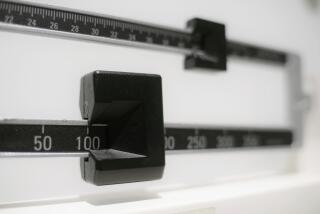Fat Products Tied to Many Diseases : Problem Often Hidden From Unknowing Consumer
- Share via
Public Voice for Food and Health Policy, a consumer research, education and advocacy organization, has developed eight easy resolutions to follow in cutting dietary fat, which has been linked increasingly to a number of major diseases, such as heart conditions, cancer and diabetes.
“In the last several years, key health organizations in the United States have suggested Americans cut dietary fat to prevent disease. We believe 1985 should be the year to launch the campaign in earnest,” said Ellen Haas, Public Voice executive director.
The American Heart Assn., the American Cancer Society and the National Institutes of Health have stated that a healthy daily diet should contain no more than 30% calories from fat, about 12% less than the current average American diet. Since fat is often hidden as an ingredient in food products, many of them American favorites, Public Voice has identified the key sources of hidden fat and has suggested eight ways to reduce consumption of those products.
Hidden Fat
According to the latest National Health Assessment and Nutrition Evaluation survey, five of the top 20 major sources of fat provide hidden fat. These five include luncheon meats; milk and cheese products; peanuts and other nuts; doughnuts, cookies and cake, and mayonnaise and salad dressings. To cut consumption of these foods, which often provide more than two-thirds of their calories from fat, Public Voice suggests three rules of thumb:
--Substitute lower-fat items for higher-fat ones.
--Cut portion sizes.
--Alter some eating habits.
These eight hints for 1985 show how:
Resolve: To eat a leaner sandwich. Cut way back on luncheon meats and hot dogs; they have more than 75% to 80% fat calories. Eat sliced breast of turkey or chicken and tuna, or try a sandwich of sprouts, sliced tomatoes, cucumbers and lettuce. Turkey gets only about 20% of its calories from fat. A new sandwich dressing can make a big difference, too. Try plain yogurt or mustard instead of mayonnaise and save 80 or more fat calories. If you must have high-fat luncheon meats, use one slice instead of two or three, and save yourself at least 50 fat calories.
Eat Fewer Pastries
Resolve: To change your breakfast bread. Eat more bagels, muffins or pita bread instead of doughnuts and Danish pastries. A raisin bran muffin rather than a honey bun cuts 24 fat calories from your diet; a bagel saves you 41 calories from fat. Making your own muffin or quick bread mix allows you to control the amount of fat even more. Try replacing one-half the oil required with skim milk or water; you can lower the fat calories in the recipe by 30% or more. And a tip for toppings: keep your butter or margarine soft for spreading thinner.
Resolve: To use cheese more as a garnish than a main dish. Slice it thinner or grate less of it for recipes. Experiment with cheeses that contain less than 70% calories from fat. Using low-fat cottage cheese instead of higher-fat ricotta in lasagna, for example, can cut at least 50 calories from an average serving. So will making pizza with partially skimmed mozzarella instead of the whole-milk variety.
Resolve: To make salad dressing. Commercial mayonnaise and salad dressings are almost pure fat--from 85% to 98% in fat calories. Low-calorie dressings from the store do help cut about 50 fat calories from your diet. But a homemade, low-fat dressing such as yogurt and dill, or lemon and tomato juice with herbs, has fewer than 20 fat calories.
Say ‘Nuts’ to Nuts
Resolve: To treat nuts as food accessories. They are large sources of hidden fat, especially most of those we eat frequently or use in baking. Pecans, for example, have 95% of their calories from fat; walnuts have 89%, and cashews and peanuts, 75%. Soybeans are the lowest with 40% fat calories. Eating dry-roasted nuts lowers the fat content only a little. As snack alternatives, freshly popped corn or even pretzels have 50% fewer fat calories per average serving. If you cut out nuts altogether when making your favorite quick bread or cookies, you’ll save 50 calories or more in fat per serving. And omitting nuts, unlike flour or sugar, will make a difference only in the flavor. Or try finely chopping a few nuts and sprinkling them on top.
Resolve: To slice and share fatty foods. Smaller wedges of cake or pie can save you from 100 to 150 extra fat calories. Share a rich restaurant dessert with a friend, or even leave some on the plate, as restaurant critics (who eat out a lot) do. One or two bites of very rich goodies usually provide 75 to 100 calories, about 60% of them from fat.
Choose Low-Fat Cookies
Resolve: To choose a lower-fat cookie. You don’t have to skip them altogether, but you could cut back and eat healthier ones. More than two-thirds of the calories in super-rich chocolate chip cookies, for example, are from fat. Lower-fat varieties include gingersnaps, animal crackers and fig bars.
Resolve: To eat fruits and vegetables. Make them into appetizers, main courses, salads, desserts and sandwiches. Less than 4% of the calories from most fruits and vegetables are from fat. They are also low in calories and salt, and full of vitamins, minerals and fiber. Treat yourself to fresh fruits and vegetables, and you’ll see a big difference in flavor. Next time you’re eating out in an ethnic or fresh-food restaurant, try a new vegetable dish for inspiration.
More to Read
Eat your way across L.A.
Get our weekly Tasting Notes newsletter for reviews, news and more.
You may occasionally receive promotional content from the Los Angeles Times.









